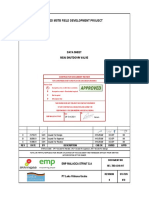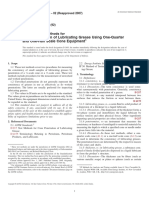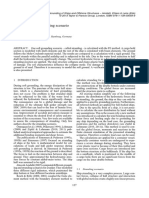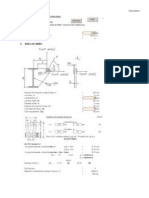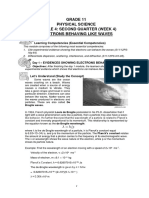Professional Documents
Culture Documents
Macroscopic Growth of Bacteria Precisely Follows The Solution of The Diffusion Equation With Boundary Conditions
Original Title
Copyright
Available Formats
Share this document
Did you find this document useful?
Is this content inappropriate?
Report this DocumentCopyright:
Available Formats
Macroscopic Growth of Bacteria Precisely Follows The Solution of The Diffusion Equation With Boundary Conditions
Copyright:
Available Formats
Volume 6, Issue 10, October – 2021 International Journal of Innovative Science and Research Technology
ISSN No:-2456-2165
Macroscopic Growth of Bacteria Precisely Follows
The Solution of the Diffusion Equation with
Boundary Conditions
1-
Dr Ismail Abbas, lecturer at MTC, Cairo University.
2-
Sherif Ismael, MSc, Faculty of Medicine, University of Cairo.
3-
Nora Abbas, PhD Prof Ass at the Faculty of Medicine, University of Cairo.
Abstract:- We provide an experimental proof showing The exponential growth, which varies among bacteria,
that the macroscopic exponential growth of bacteria on a is controlled by many environmental conditions such as
delimited 2D planar surface follows precisely the same temperature, humidity, oxygen content, acidity and by the
solution of the heat diffusion equation with the source / nature of the bacterial species itself.
sink term and the prescribed boundary conditions.
Surprising enough, the macroscopic growth of bacteria
The B-chains previously used successfully in solving the on food surface follows the resolution of the mathematical
heat equation can be applied to solve the complicated PDE diffusion equation with subscribed boundary conditions
resulting from the growth of bacteria. which is the subject of this article.
The in-depth study of experimental microbiology II. THEORY AND EXPERIMENTAL RESULTS
and the study of theoretical mathematical physics are
essential to reveal more characteristics of the growth of A. The theoretical vision of the subject
bacteria in the bounded 2D and 3D geometric space. A recent theoretical study [1] proposed that the
spatiotemporal bacterial growth / decay, n (x, t) follows the
I. INTRODUCTION same trajectory as that of the partial differential heat diffusion
equation, i.e. ,
There are many articles explaining the growth and decay
of bacteria on a microscopic level that is inspecting the time ∂n (x, t) ∂t = D∂2n (x, t) ∂x2 + r n (x, t) (1 - n (x, t)) / k . .
variable only but not its propagation in a macroscopic space. . . (1)
To our knowledge, there are only experimental and In normal conventions.
theoretical studies on the growth / decay in the number of In many real-world scenarios, including infections,
bacterial cells n in the time domain n = n (t). bacterial populations spread through 2D and 3D
configuration space. This process could be modeled using the
this is probably the first rigorous test aimed at finding a Fisher-Kolmogorov equation. [1]
relationship between the macroscopic experimental bacterial
spatiotemporal growth observed in microbiology laboratories However, there is no analytical solution for the general
n (x, t) and the theoretical spatiotemporal mathematical PDE case of the diffusion equation 1 or numerical solution in the
in mathematical physics, i.e. say combining microbiology 2D/3D space of Nabla ^ 2 especially when the boundary
and physical mathematics in a rigorous collective study. conditions 2D / 3D and the source / sink term interact.
Bacterial microbes are single-celled microorganisms Concerning the theoretical aspect which is the
lacking a nuclear membrane, metabolically active and mathematical solution of equation 1, we propose to apply the
dividing by binary fission. they are a major source of disease, so-called matrix chains B successfully used in the heat
medicine and food. diffusion equation with fixed Dirichlet boundary conditions
[2] and also with dissipative conditions at the limits of free
Bacterial growth is the proliferation of bacteria into two absorption [3].
daughter cells, in a process called binary fission. Provided
that no event occurs, the resulting daughter cells are B. The experimental vision of the subject
genetically identical to the original cell. Therefore, We performed an experiment with the macroscopic
exponential bacterial growth occurs. growth of bacteria on flat surfaces of high quality Egyptian
bread maintained at 4 centigrade, pH of 7 with NP air and
Bacterial colonies progress through four main phases of humidity.
growth: the lag phase, the log or exponential phase, the
stationary phase and finally the death or decay phase.
IJISRT21OCT596 www.ijisrt.com 1068
Volume 6, Issue 10, October – 2021 International Journal of Innovative Science and Research Technology
ISSN No:-2456-2165
We found that the macroscopic growth of bacteria equation 1, Fig. 1 with the actual square or circular BC
follows the mathematical solution of the PD diffusion prescribed.
Fig. 1:- Mathematical solution for the 2D diffusion equation with circular boundary conditions.
Below is the photo showing the experimental results of the case for two concentric circles of bacteria 2.5 and 10 centimeters
in diameter.
Fig. 2:- Macroscopic growth of bacteria.
IJISRT21OCT596 www.ijisrt.com 1069
Volume 6, Issue 10, October – 2021 International Journal of Innovative Science and Research Technology
ISSN No:-2456-2165
7 days Growth of bacteria on a flat food surface (high quality Egyptian bread) maintained at 4 degrees Celsius with a pH of 7,
normal air and humidity.
The analogy between Fig. 2 and Fig. 1 is obvious.
Fig. 3:- The macroscopic death phase of the bacterial experiment of Fig. 2.
IJISRT21OCT596 www.ijisrt.com 1070
Volume 6, Issue 10, October – 2021 International Journal of Innovative Science and Research Technology
ISSN No:-2456-2165
Three weeks decay of bacteria on a flat food surface
(high quality Egyptian bread) maintained at 4 degrees Celsius
with a pH of 7, normal air and humidity
Note that macroscopic shrinkage and drying in rigor
mortis propagates in the opposite direction to the growth
phase.
III. CONCLUSION
The current article is a small step on a long road.
It shows that the macroscopic exponential growth of
bacteria follows the spatiotemporal partial differential
diffusion equation with boundary conditions.
We propose that a more in-depth study of experimental
microbiology and a theoretical study of mathematical physics
is important to reveal more features of bacteria growth in 2D
and 3D geometric space with boundary conditions.
REFERENCES
[1]. Published online 2018 Oct 1.
doi: 10.1088/1361-6633/aae546
[2]. I. Abbas , IJISRT, A Numerical Statistical Solution to
Laplace and Poisson Partial Differential Equations,
Volume 5, Number11, November - 2020
[3]. I. Abbas , IJISRT, A Time-Dependent Numerical
Statistical Solution of the Partial Differential Heat
Diffusion Equation, Volume 6, Issue 1, January - 2021.
[4]. I. Abbas ,Theory and design of audio rooms-
Reformulation of Sabine Formula, IJISRT review, Vol
6 Oct 2021 , Researchgate, October 2021
IJISRT21OCT596 www.ijisrt.com 1071
You might also like
- Never Split the Difference: Negotiating As If Your Life Depended On ItFrom EverandNever Split the Difference: Negotiating As If Your Life Depended On ItRating: 4.5 out of 5 stars4.5/5 (838)
- Shoe Dog: A Memoir by the Creator of NikeFrom EverandShoe Dog: A Memoir by the Creator of NikeRating: 4.5 out of 5 stars4.5/5 (537)
- Diabetic Retinopathy Stage Detection Using CNN and Inception V3Document9 pagesDiabetic Retinopathy Stage Detection Using CNN and Inception V3International Journal of Innovative Science and Research TechnologyNo ratings yet
- Exploring the Molecular Docking Interactions between the Polyherbal Formulation Ibadhychooranam and Human Aldose Reductase Enzyme as a Novel Approach for Investigating its Potential Efficacy in Management of CataractDocument7 pagesExploring the Molecular Docking Interactions between the Polyherbal Formulation Ibadhychooranam and Human Aldose Reductase Enzyme as a Novel Approach for Investigating its Potential Efficacy in Management of CataractInternational Journal of Innovative Science and Research TechnologyNo ratings yet
- Investigating Factors Influencing Employee Absenteeism: A Case Study of Secondary Schools in MuscatDocument16 pagesInvestigating Factors Influencing Employee Absenteeism: A Case Study of Secondary Schools in MuscatInternational Journal of Innovative Science and Research TechnologyNo ratings yet
- An Analysis on Mental Health Issues among IndividualsDocument6 pagesAn Analysis on Mental Health Issues among IndividualsInternational Journal of Innovative Science and Research TechnologyNo ratings yet
- Harnessing Open Innovation for Translating Global Languages into Indian LanuagesDocument7 pagesHarnessing Open Innovation for Translating Global Languages into Indian LanuagesInternational Journal of Innovative Science and Research TechnologyNo ratings yet
- The Utilization of Date Palm (Phoenix dactylifera) Leaf Fiber as a Main Component in Making an Improvised Water FilterDocument11 pagesThe Utilization of Date Palm (Phoenix dactylifera) Leaf Fiber as a Main Component in Making an Improvised Water FilterInternational Journal of Innovative Science and Research TechnologyNo ratings yet
- Advancing Healthcare Predictions: Harnessing Machine Learning for Accurate Health Index PrognosisDocument8 pagesAdvancing Healthcare Predictions: Harnessing Machine Learning for Accurate Health Index PrognosisInternational Journal of Innovative Science and Research TechnologyNo ratings yet
- The Relationship between Teacher Reflective Practice and Students Engagement in the Public Elementary SchoolDocument31 pagesThe Relationship between Teacher Reflective Practice and Students Engagement in the Public Elementary SchoolInternational Journal of Innovative Science and Research TechnologyNo ratings yet
- The Making of Object Recognition Eyeglasses for the Visually Impaired using Image AIDocument6 pagesThe Making of Object Recognition Eyeglasses for the Visually Impaired using Image AIInternational Journal of Innovative Science and Research TechnologyNo ratings yet
- Design, Development and Evaluation of Methi-Shikakai Herbal ShampooDocument8 pagesDesign, Development and Evaluation of Methi-Shikakai Herbal ShampooInternational Journal of Innovative Science and Research Technology100% (3)
- Dense Wavelength Division Multiplexing (DWDM) in IT Networks: A Leap Beyond Synchronous Digital Hierarchy (SDH)Document2 pagesDense Wavelength Division Multiplexing (DWDM) in IT Networks: A Leap Beyond Synchronous Digital Hierarchy (SDH)International Journal of Innovative Science and Research TechnologyNo ratings yet
- Terracing as an Old-Style Scheme of Soil Water Preservation in Djingliya-Mandara Mountains- CameroonDocument14 pagesTerracing as an Old-Style Scheme of Soil Water Preservation in Djingliya-Mandara Mountains- CameroonInternational Journal of Innovative Science and Research TechnologyNo ratings yet
- The Impact of Digital Marketing Dimensions on Customer SatisfactionDocument6 pagesThe Impact of Digital Marketing Dimensions on Customer SatisfactionInternational Journal of Innovative Science and Research TechnologyNo ratings yet
- Formulation and Evaluation of Poly Herbal Body ScrubDocument6 pagesFormulation and Evaluation of Poly Herbal Body ScrubInternational Journal of Innovative Science and Research TechnologyNo ratings yet
- Electro-Optics Properties of Intact Cocoa Beans based on Near Infrared TechnologyDocument7 pagesElectro-Optics Properties of Intact Cocoa Beans based on Near Infrared TechnologyInternational Journal of Innovative Science and Research TechnologyNo ratings yet
- Comparatively Design and Analyze Elevated Rectangular Water Reservoir with and without Bracing for Different Stagging HeightDocument4 pagesComparatively Design and Analyze Elevated Rectangular Water Reservoir with and without Bracing for Different Stagging HeightInternational Journal of Innovative Science and Research TechnologyNo ratings yet
- Auto Encoder Driven Hybrid Pipelines for Image Deblurring using NAFNETDocument6 pagesAuto Encoder Driven Hybrid Pipelines for Image Deblurring using NAFNETInternational Journal of Innovative Science and Research TechnologyNo ratings yet
- Review of Biomechanics in Footwear Design and Development: An Exploration of Key Concepts and InnovationsDocument5 pagesReview of Biomechanics in Footwear Design and Development: An Exploration of Key Concepts and InnovationsInternational Journal of Innovative Science and Research TechnologyNo ratings yet
- A Survey of the Plastic Waste used in Paving BlocksDocument4 pagesA Survey of the Plastic Waste used in Paving BlocksInternational Journal of Innovative Science and Research TechnologyNo ratings yet
- Hepatic Portovenous Gas in a Young MaleDocument2 pagesHepatic Portovenous Gas in a Young MaleInternational Journal of Innovative Science and Research TechnologyNo ratings yet
- Explorning the Role of Machine Learning in Enhancing Cloud SecurityDocument5 pagesExplorning the Role of Machine Learning in Enhancing Cloud SecurityInternational Journal of Innovative Science and Research TechnologyNo ratings yet
- Cyberbullying: Legal and Ethical Implications, Challenges and Opportunities for Policy DevelopmentDocument7 pagesCyberbullying: Legal and Ethical Implications, Challenges and Opportunities for Policy DevelopmentInternational Journal of Innovative Science and Research TechnologyNo ratings yet
- Automatic Power Factor ControllerDocument4 pagesAutomatic Power Factor ControllerInternational Journal of Innovative Science and Research TechnologyNo ratings yet
- Navigating Digitalization: AHP Insights for SMEs' Strategic TransformationDocument11 pagesNavigating Digitalization: AHP Insights for SMEs' Strategic TransformationInternational Journal of Innovative Science and Research TechnologyNo ratings yet
- Studying the Situation and Proposing Some Basic Solutions to Improve Psychological Harmony Between Managerial Staff and Students of Medical Universities in Hanoi AreaDocument5 pagesStudying the Situation and Proposing Some Basic Solutions to Improve Psychological Harmony Between Managerial Staff and Students of Medical Universities in Hanoi AreaInternational Journal of Innovative Science and Research TechnologyNo ratings yet
- Mobile Distractions among Adolescents: Impact on Learning in the Aftermath of COVID-19 in IndiaDocument2 pagesMobile Distractions among Adolescents: Impact on Learning in the Aftermath of COVID-19 in IndiaInternational Journal of Innovative Science and Research TechnologyNo ratings yet
- A Review: Pink Eye Outbreak in IndiaDocument3 pagesA Review: Pink Eye Outbreak in IndiaInternational Journal of Innovative Science and Research TechnologyNo ratings yet
- Drug Dosage Control System Using Reinforcement LearningDocument8 pagesDrug Dosage Control System Using Reinforcement LearningInternational Journal of Innovative Science and Research TechnologyNo ratings yet
- The Effect of Time Variables as Predictors of Senior Secondary School Students' Mathematical Performance Department of Mathematics Education Freetown PolytechnicDocument7 pagesThe Effect of Time Variables as Predictors of Senior Secondary School Students' Mathematical Performance Department of Mathematics Education Freetown PolytechnicInternational Journal of Innovative Science and Research TechnologyNo ratings yet
- Formation of New Technology in Automated Highway System in Peripheral HighwayDocument6 pagesFormation of New Technology in Automated Highway System in Peripheral HighwayInternational Journal of Innovative Science and Research TechnologyNo ratings yet
- The Subtle Art of Not Giving a F*ck: A Counterintuitive Approach to Living a Good LifeFrom EverandThe Subtle Art of Not Giving a F*ck: A Counterintuitive Approach to Living a Good LifeRating: 4 out of 5 stars4/5 (5794)
- The Yellow House: A Memoir (2019 National Book Award Winner)From EverandThe Yellow House: A Memoir (2019 National Book Award Winner)Rating: 4 out of 5 stars4/5 (98)
- Hidden Figures: The American Dream and the Untold Story of the Black Women Mathematicians Who Helped Win the Space RaceFrom EverandHidden Figures: The American Dream and the Untold Story of the Black Women Mathematicians Who Helped Win the Space RaceRating: 4 out of 5 stars4/5 (894)
- The Little Book of Hygge: Danish Secrets to Happy LivingFrom EverandThe Little Book of Hygge: Danish Secrets to Happy LivingRating: 3.5 out of 5 stars3.5/5 (399)
- Elon Musk: Tesla, SpaceX, and the Quest for a Fantastic FutureFrom EverandElon Musk: Tesla, SpaceX, and the Quest for a Fantastic FutureRating: 4.5 out of 5 stars4.5/5 (474)
- A Heartbreaking Work Of Staggering Genius: A Memoir Based on a True StoryFrom EverandA Heartbreaking Work Of Staggering Genius: A Memoir Based on a True StoryRating: 3.5 out of 5 stars3.5/5 (231)
- Grit: The Power of Passion and PerseveranceFrom EverandGrit: The Power of Passion and PerseveranceRating: 4 out of 5 stars4/5 (587)
- Devil in the Grove: Thurgood Marshall, the Groveland Boys, and the Dawn of a New AmericaFrom EverandDevil in the Grove: Thurgood Marshall, the Groveland Boys, and the Dawn of a New AmericaRating: 4.5 out of 5 stars4.5/5 (266)
- On Fire: The (Burning) Case for a Green New DealFrom EverandOn Fire: The (Burning) Case for a Green New DealRating: 4 out of 5 stars4/5 (73)
- The Emperor of All Maladies: A Biography of CancerFrom EverandThe Emperor of All Maladies: A Biography of CancerRating: 4.5 out of 5 stars4.5/5 (271)
- The Hard Thing About Hard Things: Building a Business When There Are No Easy AnswersFrom EverandThe Hard Thing About Hard Things: Building a Business When There Are No Easy AnswersRating: 4.5 out of 5 stars4.5/5 (344)
- The Unwinding: An Inner History of the New AmericaFrom EverandThe Unwinding: An Inner History of the New AmericaRating: 4 out of 5 stars4/5 (45)
- Team of Rivals: The Political Genius of Abraham LincolnFrom EverandTeam of Rivals: The Political Genius of Abraham LincolnRating: 4.5 out of 5 stars4.5/5 (234)
- The World Is Flat 3.0: A Brief History of the Twenty-first CenturyFrom EverandThe World Is Flat 3.0: A Brief History of the Twenty-first CenturyRating: 3.5 out of 5 stars3.5/5 (2219)
- The Gifts of Imperfection: Let Go of Who You Think You're Supposed to Be and Embrace Who You AreFrom EverandThe Gifts of Imperfection: Let Go of Who You Think You're Supposed to Be and Embrace Who You AreRating: 4 out of 5 stars4/5 (1090)
- The Sympathizer: A Novel (Pulitzer Prize for Fiction)From EverandThe Sympathizer: A Novel (Pulitzer Prize for Fiction)Rating: 4.5 out of 5 stars4.5/5 (119)
- Her Body and Other Parties: StoriesFrom EverandHer Body and Other Parties: StoriesRating: 4 out of 5 stars4/5 (821)
- SEL-TBD-I-DS-017 - R0 - Data Sheet For MSAI Shutdown Valve - SignDocument4 pagesSEL-TBD-I-DS-017 - R0 - Data Sheet For MSAI Shutdown Valve - SignhadiNo ratings yet
- Astm D4317 98Document3 pagesAstm D4317 98Abril CampuzanoNo ratings yet
- Prof DontwiDocument122 pagesProf DontwiRexford AmponsahNo ratings yet
- AC Assignment QuestionsDocument3 pagesAC Assignment QuestionsSudarshanNo ratings yet
- Circumferential Road, Bitoon-Aguada, Ozamiz City, Misamis OccidentDocument3 pagesCircumferential Road, Bitoon-Aguada, Ozamiz City, Misamis OccidentMaria Angelica Rodriguez AlonsoNo ratings yet
- Combe and Hartig 2006Document10 pagesCombe and Hartig 2006Komathi MuruganNo ratings yet
- ASTM D 70 - 03 Standard Test Method ForDocument3 pagesASTM D 70 - 03 Standard Test Method ForBiswakalyan Mishra100% (1)
- FALLSEM2020-21 MEE1003 TH VL2020210103023 Reference Material I 31-Jul-2020 First Law of Thermodynamics - IIDocument52 pagesFALLSEM2020-21 MEE1003 TH VL2020210103023 Reference Material I 31-Jul-2020 First Law of Thermodynamics - IIRahul rajelliNo ratings yet
- GW Geoweb GW30v6 SummaryDocument1 pageGW Geoweb GW30v6 SummaryChowdhury PriodeepNo ratings yet
- GCSE Mathematics A or Better Revison SheetsDocument47 pagesGCSE Mathematics A or Better Revison SheetsHannah PatelNo ratings yet
- Carbonyl Iron Powder For Diamond ToolsDocument3 pagesCarbonyl Iron Powder For Diamond ToolsYosu UgaldeNo ratings yet
- Cone Penetration of Lubricating Grease Using One-Quarter and One-Half Scale Cone EquipmentDocument8 pagesCone Penetration of Lubricating Grease Using One-Quarter and One-Half Scale Cone EquipmentAhmedNo ratings yet
- 622 MBPS, 1310 NM Uncooled Fabry-Perot Laser Diode Module With MonitorDocument9 pages622 MBPS, 1310 NM Uncooled Fabry-Perot Laser Diode Module With MonitorIsaac Huixtlaca CuatecatlNo ratings yet
- General Wave Properties 3 QPDocument8 pagesGeneral Wave Properties 3 QPAli SiddiqNo ratings yet
- Fischerscope X-Ray Xan 220Document4 pagesFischerscope X-Ray Xan 220varun sachdevaNo ratings yet
- Physical Chemistry: Thermodynamics, Structure, and Change: Tenth Edition ART Powerpoint PresentationsDocument36 pagesPhysical Chemistry: Thermodynamics, Structure, and Change: Tenth Edition ART Powerpoint PresentationsVincent PradjinataNo ratings yet
- Calculation of A Stranding ScenarioDocument8 pagesCalculation of A Stranding ScenarioamNo ratings yet
- LIFTING LUG DESIGN CALCULATIONDocument12 pagesLIFTING LUG DESIGN CALCULATIONsurefooted1No ratings yet
- Power Magnetics Engineered to Your DesignDocument85 pagesPower Magnetics Engineered to Your Designrafael quiaroNo ratings yet
- Upload MetallergyDocument2 pagesUpload MetallergyManoj MandavkarNo ratings yet
- Humidity and Heat in MinesDocument45 pagesHumidity and Heat in MinesAhsan AliNo ratings yet
- Light Detection and Ranging (LIDAR)Document25 pagesLight Detection and Ranging (LIDAR)sonusangamNo ratings yet
- Intro Electric Machines and DrivesDocument4 pagesIntro Electric Machines and DrivesArmando MaloneNo ratings yet
- 2019 AWRF WRSLGDocument24 pages2019 AWRF WRSLGElias JarjouraNo ratings yet
- General Chemistry 2 Grade 12Document10 pagesGeneral Chemistry 2 Grade 12Shylene Mae JapsonNo ratings yet
- Screenshot 2023-02-18 at 14.55.23Document35 pagesScreenshot 2023-02-18 at 14.55.23Christopher SleimanNo ratings yet
- Service Manual Liftstar-2014Document46 pagesService Manual Liftstar-2014Adam SchwemleinNo ratings yet
- Grade 11 Physical Science Module 4: Second Quarter (Week 4) Electrons Behaving Like WavesDocument8 pagesGrade 11 Physical Science Module 4: Second Quarter (Week 4) Electrons Behaving Like Wavesdanniel100% (1)
- Zhang Et Al-2013-Scientific ReportsDocument6 pagesZhang Et Al-2013-Scientific Reportscbs78No ratings yet
- MAQ. DE SORVETE C630-C1030 TAYLOR Manual TécnicoDocument18 pagesMAQ. DE SORVETE C630-C1030 TAYLOR Manual TécnicoFernanda DamasoNo ratings yet







































































